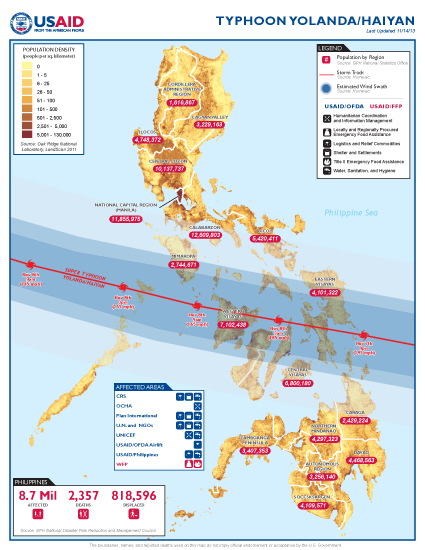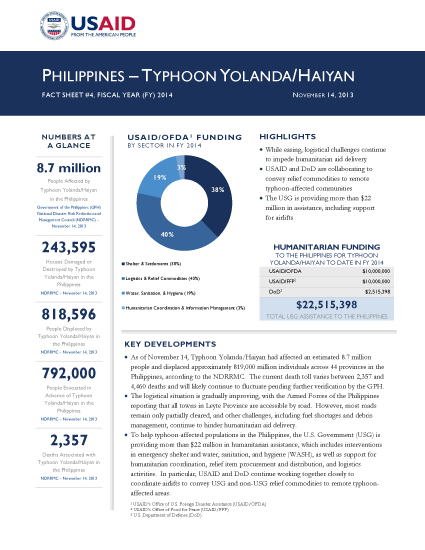- What We Do
- Agriculture and Food Security
- Democracy, Human Rights and Governance
- Economic Growth and Trade
- Education
- Environment and Global Climate Change
- Gender Equality and Women's Empowerment
- Global Health
- Humanitarian Assistance
- Transformation at USAID
- Water and Sanitation
- Working in Crises and Conflict
- U.S. Global Development Lab
Speeches Shim
November 14, 2013
Numbers At A Glance
8.7 million
243,595
818,596
792,000
2,357
Humanitarian Funding:
To The Philippines For Typhoon Haiyan/Yolanda To Date In FY2014:

| USAID/OFDA | $10,000,000 |
| USAID/FFP | $10,000,000 |
| DoD | $2,515,398 |
| TOTAL | $22,515,398 |
Typhoon Haiyan / Yolanda Fact Sheet #4 - 11/14/2013 ![]() (pdf - 206k)
(pdf - 206k)
Highlights
While easing, logistical challenges continue to impede humanitarian aid delivery
USAID and DoD are collaborating to convey relief commodities to remote typhoon-affected communities
The USG is providing more than $22 million in assistance, including support for airlifts
Key Developments
As of November 14, Typhoon Yolanda/Haiyan had affected an estimated 8.7 million people and displaced approximately 819,000 million individuals across 44 provinces in the Philippines, according to the NDRRMC. The current death toll varies between 2,357 and 4,460 deaths and will likely continue to fluctuate pending further verification by the GPH.
The logistical situation is gradually improving, with the Armed Forces of the Philippines reporting that all towns in Leyte Province are accessible by road. However, most roads remain only partially cleared, and other challenges, including fuel shortages and debris management, continue to hinder humanitarian aid delivery.
To help typhoon-affected populations in the Philippines, the U.S. Government (USG) is providing more than $22 million in humanitarian assistance, which includes interventions in emergency shelter and water, sanitation, and hygiene (WASH), as well as support for humanitarian coordination, relief item procurement and distribution, and logistics activities. In particular, USAID and DoD continue working together closely to coordinate airlifts to convey USG and non-USG relief commodities to remote typhoon-affected areas.
SHELTER & SETTLEMENTS
- Emergency shelter remains a priority need in the immediate aftermath of the typhoon, which damaged or destroyed approximately 244,000 houses, according to the NDRRMC, although shelter partners estimate that the number of damaged homes could be much higher. USAID disaster experts note that the destruction resulting from the typhoon and associated storm surge has resulted in massive amounts of debris that will require a large-scale debris management plan to facilitate both immediate relief and medium-term recovery efforts.
- The Shelter Cluster—the coordinating body for shelter-related humanitarian activities—plans to maintain a presence in Cebu, Manila, and Roxas cities. Assessments by Shelter Cluster members are ongoing in affected areas.
- USAID/OFDA is supporting the GPH shelter-in-place approach through DoD transport of USAID/OFDA-provided plastic sheeting, which affected populations can use in combination with locally available materials to create temporary shelters. Through more than $3.1 million, USAID/OFDA is also supporting several partners to distribute shelter kits to typhoon-affected households.
WASH
- In most-affected Tacloban, the typhoon caused significant damage to the public water system, resulting in minimal availability of public water in the city and eight surrounding municipalities. In Ormoc city, local authorities report that the water system is intact but needs to be tested for contamination. Groundwater supplies remain contaminated in most storm-affected communities. In total, the NDRRMC reports that approximately 240 municipalities lack electricity and, as a result, water systems in these areas that rely on power to pump water may not be fully functional. WASH rapid needs assessment teams have arrived in Leyte, Samar, Iloilo, Cebu, and Aklan provinces to determine WASH-related humanitarian needs, according to the U.N.
- GPH priority needs for WASH include portable water treatment systems and generators, water trucking systems, household water treatment supplies, water containers, and hygiene kits, as well as related hygiene promotion activities.
- USAID/OFDA has provided nearly $1.6 million to date for WASH activities in affected areas. USAID/OFDA partners are providing point-of-use water treatment solutions for household-level treatment and utilizing bulk chlorine for larger-scale treatment, as well as providing water containers to assist with distribution. Additional USAID/OFDA-supported WASH activities include improving the availability of safe drinking water by mobilizing water tanks, installing mobile water treatment units, and establishing communal water points, as well as restoring access to latrines and conducting hygiene promotion activities.
FOOD SECURITY
- On November 14, the NDRRMC increased its estimate of agricultural and infrastructure damages caused by Typhoon Yolanda/Haiyan to approximately $93 million, a fivefold increase from the $17.4 million reported the previous day. The NDRRMC also noted the storm-related destruction of some 177,000 acres of land planted with rice, corn, and other crops, resulting in the loss of more than 138,000 metric tons (MT) of food crops.
- On November 13, the U.N. World Food Program (WFP) released an emergency operation document, requesting $88 million to support an estimated 2.5 million typhoon-affected people who will likely require food assistance during the next six months. To date, USAID/FFP has committed $10 million toward WFP’s response in the Philippines.
- As of November 14, approximately 55 MT of USAID/FFP emergency food commodities—airlifted from a USAID/FFP warehouse in Miami, Florida—had arrived in Cebu and were en route to Tacloban. The food commodities, comprising nutrition-dense food bars and other food items that do not require cooking, are sufficient to feed 15,000 adults and 20,000 children for five days.
- Through a cash contribution, USAID/FFP has enabled WFP to purchase 2,500 metric tons of rice in local markets for inclusion in the family food packs that the GPH Department of Social Welfare and Development is distributing to typhoon-affected populations. On November 13, nearly 50,000 people in Tacloban city and nearby areas received the food packs, which supply more than 6 pounds of rice and canned goods—an amount adequate to feed a family of five for up to three days. The USAID/FFP funds have also allowed WFP to procure 555,000 packets of high-energy biscuits, which arrived in Tacloban on November 13 for onward distribution to evacuees and other vulnerable populations in typhoon-affected areas.
OTHER HUMANITARIAN ASSISTANCE
- On November 14, USAID/OFDA committed $250,000 to the U.N. Office for the Coordination of Humanitarian Affairs (OCHA) to support humanitarian coordination and information management to improve typhoon response efforts in affected areas. As of November 14, international donors had pledged nearly $118 million to address humanitarian needs among populations affected by Typhoon Yolanda/Haiyan. The total amount pledged represents approximately 39 percent of the $301 million requested by the U.N. Humanitarian Action Plan for the Philippines typhoon response.
- In addition to funds, international donors also continue to send relief items, equipment, and personnel to assist in the Philippines. On November 12, the Government of Japan announced plans to provide up to $600,000 of emergency relief items, which include plastic sheeting and sleeping pads. On November 14, the U.K. Department for International Development reported that the British military is contributing 100 MT of airfield handling equipment to facilitate the offloading of relief supplies.



Comment
Make a general inquiry or suggest an improvement.